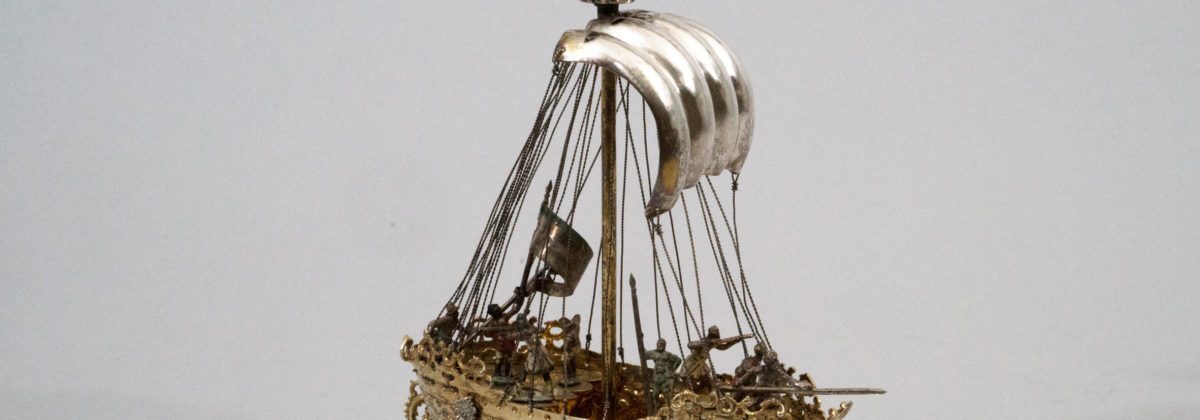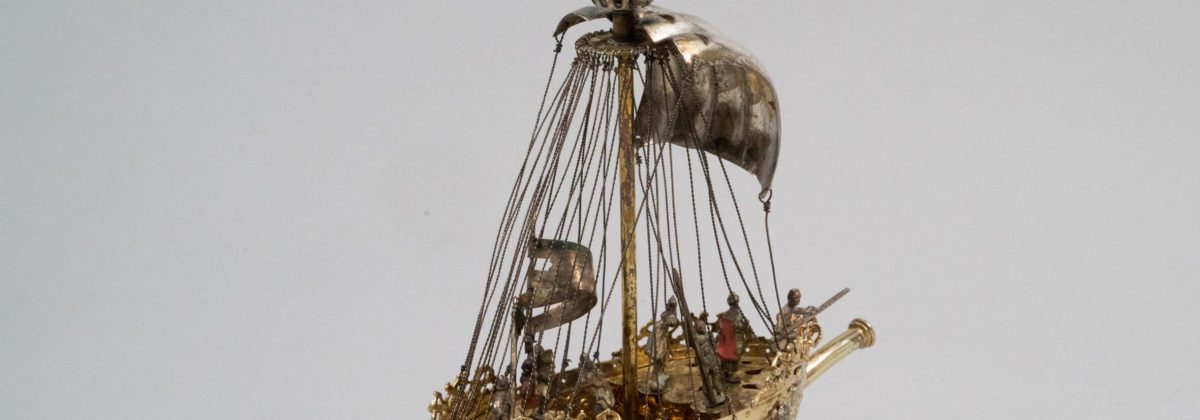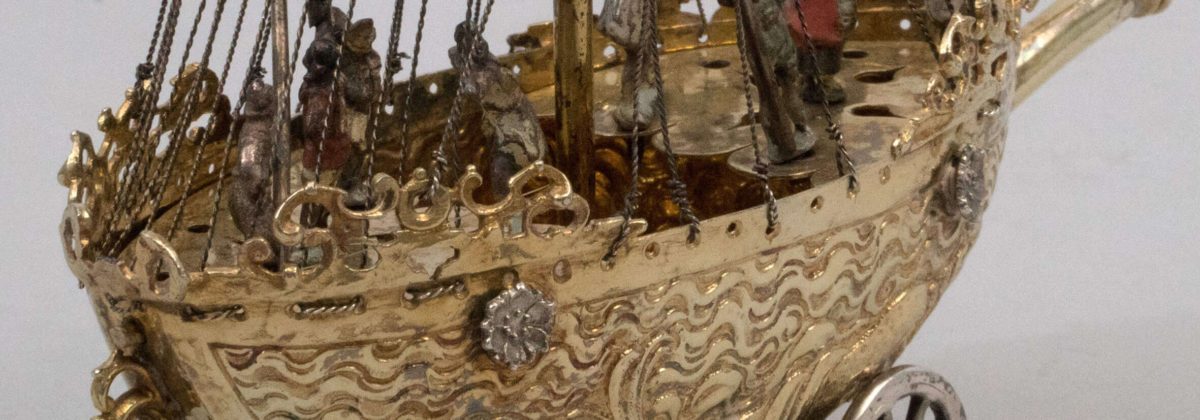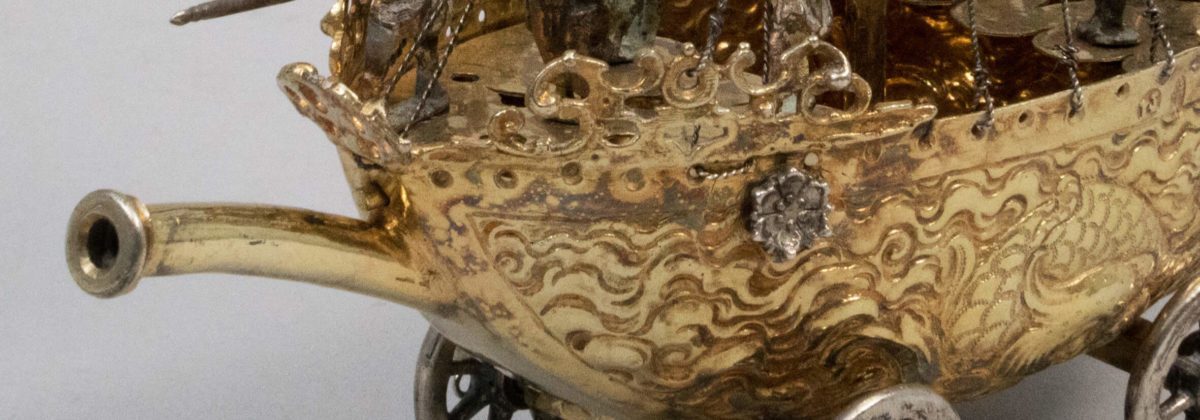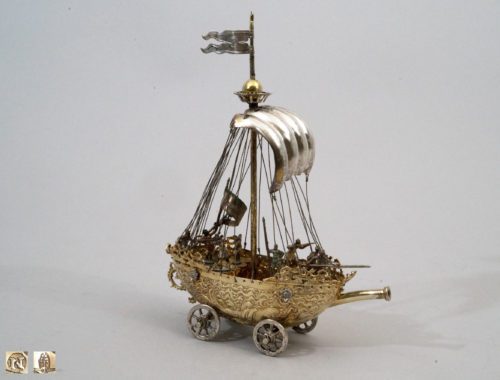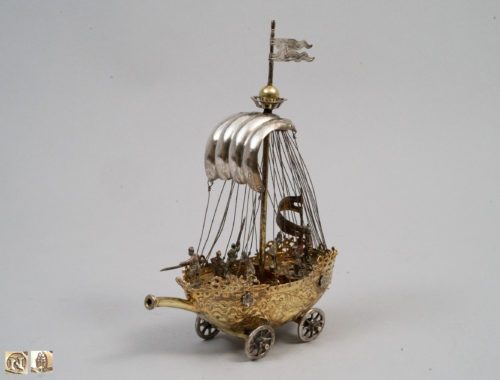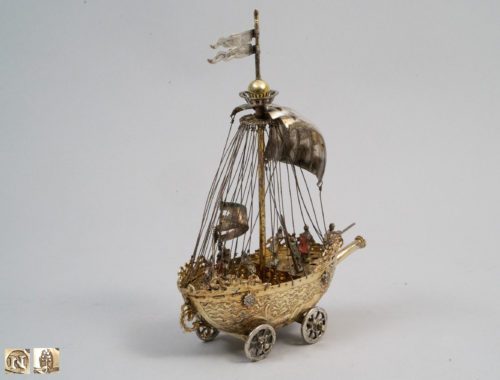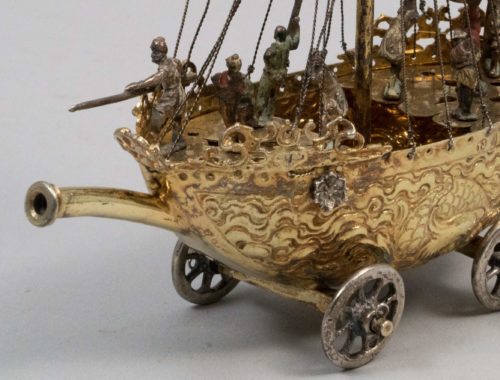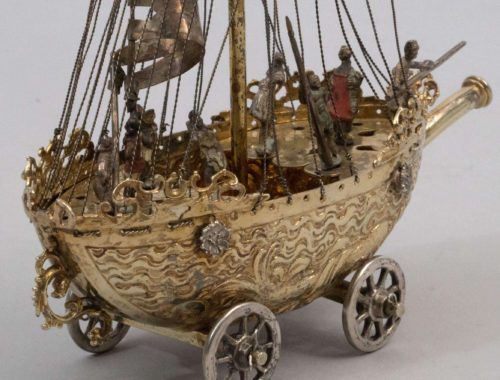Object number #278
Nuremberg, around 1609/1629
Hallmark: N in the round, Nuremberg 1609/1629 (Nuremberg goldsmith art 2007, BZ13)
Maker’s mark: Esaias zur Linden (R3 MZ4135d; Nürnberger Goldschmiedekunst 2007, MZ0527a); a stylized linden tree with 3 gnarled roots in the high oval
Silver, embossed, cast, punched, chased, partially gilded; partial color version in cold enamel
Height: 21cm, Length: 16.2cm, Width: 6.2cm
Detailed Description
Detailed information
Such magnificently designed silver drinking vessels were considered a special highlight of early modern drinking culture. Used to present status at court, whilst also being popular from the princely court to the patriciate of the leading imperial cities. Placed in a prominent position in front of the guest of honor at the table, it served to fascinate and amuse the assembled dining party.
The silver miniature sailing ship made by Esaias zur Linden could be effectively pushed over the table on wheels during the feast.
Designed to function such that the ship’s belly was filled with liquid, and drunk though the drinking tuber at the ships bow. The drinker faced the challenge of dodging the defensive lance of the “Moor”, designed such as to protrude directly at the nose of the brave drinking companion. The delicate volute clasp on the stern served as a handle for the drinking vessel, which had to be lifted to drink.
Esaias zur Linden’s particularly narrative depiction shows a well-fortified ship’s crew, consisting of 8 small, bearded soldiers of various origins, some with turbans and harem pants others with coats and helmets. While items of clothing such as turbans and harem pants are reminiscent of Moors, the appearance of the headgear varies between the rifleman’s hood and the slouch hat of the simple western ship’s crew – a motley exotic bunch. The crew stands on an aesthetically curved openwork front and rear deck. With great vehemence, the soldiers defend the ship with rifles and lances at their ready. The commander-in-chief is a fighter armed with breastplate and helmet alongside a raised lance. The characters make himself known, standing out from the defenders with his erect posture and distant gaze. The ship is steered by a man with a helmet cap, who sits on the starboard side opposite the sail and controls the ship’s direction of travel with a “Kolder stick”. Next to it, a helmeted soldier waves a flag.
The inflated silver sail, divided into four bulges, “drives” the ship in the direction of the drinker. A double-tongued flag on the mast, with a crescent moon on one side and a star on the other, flutters in the opposite direction in the headwind: the sailor is therefore “at full speed” on the move. Twisted silver wires serve as ropes. They connect the sail to the ship’s railing. The gold-plated ball in the masthead can be found on numerous other drinking ships with wheels from Esaias zur Linden.
Two mythical maritime creatures adorn the body of the ship on the long sides, reminiscent of dolphins despite the partial scale-like pattern. The undulating sea surface is elaborately embossed and engraved, and the scales of the sea creatures are partially punched. Towards the bow and stern are churning waves in the form of tails playing over the otherwise straight railing of the sailing ship. Mounts on the ship’s side wall are concealed by four intricately designed silver blossoms. The gilding of the ship’s hull, mast, ball and drinking tube contrasts with the white and silver polished surfaces of the sail, the flag on the mast, the wheels, blossoms and sparkling lances. Particularly noteworthy is the rarely preserved color version of the cast figurines and the flag raised by the soldier. For the goldsmith and the owner, it was not the “functionality” of the ship that was important, but rather its aesthetic and perfect form. The colorful cold enamels in red, green and blue, which are unusual for our viewing habits were not uncommon on Nuremberg drinking vessels at the beginning of the 17th century but have only been preserved in a few cases. On the one hand, they underscored the naturalism of the scene, while at the same time clarifying the precious character of the elaborately designed ship. In its shape and features, the drinking vessel, which functions as a humorous vessel, fits seamlessly into the Nuremberg drinking ships of its time.
Nuremberg drinking vessels and their spread
Table ships have been used at princely courts as table decorations or showpieces on buffets since the 14th century. Drinking vessels from Nuremberg have been known since the beginning of the 16th century. They were particularly fashionable in the first half of the 17th century. Some Nuremberg goldsmiths, in particular Georg Müllner, Tobias Wolff and Esaias zur Linden, specialised in the manufacture of these elaborate goblets to meet the high demand for the elaborately decorated drinking games. However, no other master was as prolific in this profession as Esaias zur Linden: the present table ship – like many other ship goblets and drinking ships on wheels – was made by the well-known goldsmith master.
Historical context
In medieval France vessels in the shape of a ship were used to store wine, spices and and as drinking cups for lords. Spiking drinks was a relatively common act in the Middle Ages, thereby using such ships assisted in assuring the Lord/drinker that their food and drink were free of poison. Ship-shaped implements were also used in a religious context (e.g., as a censer). These served as a symbol of the Church and of God for man’s salvation. There are also reports of ships being made from silver and other precious materials, which were brought to the church as votive offerings for a safe return from a perilous voyage. For example, Margaret of Provence (1221-1295), a nef of the church of Saint-Nicolas in Saint-Nicolas-de-Port in Lorraine, donated in 1254 as a token of her gratitude for the safe return of her family. In the German cultural area and in Central and Western Europe, ships have been known as drinking vessels or centerpieces since the early 16th century. On the occasion of the marriage of Wilhelm V of Bavaria to Renata of Lorraine in 1568, there were 20 salt vessels in the form of ships, all silver or silver gilded (Lehne 1985: 84). According to the latest research, they were also used as salt and spice vessels in the 17th century. The decoration of a table is certainly in the foreground when hosting a dinner, thereby such ships were placed near the most important guest at the table. Ships that do not have a spout or drinking tube served as salt vessels or were intended to represent the transport of salt, as a new archival report from Gdańsk proves. Vessels were a status symbol and were meant to symbolize the importance of a particular guest at the table. In addition, the ship is considered a symbol of a fulfilled and long life. As great centers of goldsmithing in southern Germany, Augsburg and Nuremberg also specialised in the manufacture of ships. Ships should also be considered in connection with the popularity and variety of table fountains in the 16th and 17th centuries (see Wiewelhove, 2002, pp. 91-2). The imagination and artistic/craftsmanship of the Augsburg and Nuremberg masters unfolded masterfully in this period through the manufacture of table and puzzle devices. In general, such ships were not replicas of existing ships. Rather, these were evidence of the creative imagination of the master, who used existing designs of ships – contemporary or even older – as models. Nefs were very popular luxury vessels up until the late 19th century and were often given as exceptional gifts. A very fine, historically important example in the musée des arts décoratifs in Paris shows the symbolic power of ships. For the goldsmiths in southern Germany, the key field ship (ca. 1503) (in the Germanic National Museum, Nuremberg) was probably a constant reference. This, however, was a vessel clearly made for drinking. Similar to the key fields ship, the master of the present ship has chosen to show an alarming scene in the everyday life of the ship. The ship’s crew is highly concentrated on the deck and looks into the distance. The ship represents an important moment in his life at sea. This should give the guests at a dinner an opportunity to talk about the symbolism of the ship, its origin and the craftsmanship of the master.
Maker:
The goldsmith Esaias zur Linden learnt the goldsmith’s trade from 1593 with Hans Peter Rahn, a goldsmith from Zurich. He received citizenship in Zurich in 1607 and completed the master’s examination in 1609. As early as 1610 he was able to afford the increased fees for newcomers to acquire citizenship in Nuremberg and worked in the imperial city of Nuremberg until his death in 1632.
Between 1610 and his death in 1632, Esaias zur Linden created more than 60 ship goblets and drinking vessels on wheels, tankards and credenzas, the setting of two rock crystal goblets, a rhinoceros horn bowl and several grape goblets.
Zur Linden’s table ships achieved world fame and are now in renowned museums such as the Metropolitan Museum in New York, the Nationalmuseet Copenhagen, the Hermitage St. Petersburg, the armory of the Moscow Kremlin, the Victoria & Albert Museum in London, the Landesmuseum Württemberg in Stuttgart, the Krakauer Wawel, the Bielefeld arts and crafts collection – Hülsmann Foundation, the Swiss National Museum in Zurich (also with cold enamel), the Applied Arts collection, Kassel museum landscape hesse kassel (with cold enamel), the Kunsthistorisches Museum in Vienna, and other important collections.
Provenance
According to the contents inventory of December 1886, the present nave comes from the collection of Baron Carl von Rothschild in Gunthersburg. It ended up in a European private collection via his daughter, Baroness James de Rothschild, and from there in 2018 in the art dealer J. Kugel, Paris. The object is also mentioned by Marc Rosenberg in R3, Vol. 3, 1923 under MZ4135d.
Sources:
Contents inventory of the collection of Baron Carl von Rothschild in Gunthersburg, December 1886
Literature:
Bachtler, Monika, Syndram, Dirk and Weinhold, Ulrike (eds.): The fascination of collecting: Masterpieces of the goldsmith’s art from the Rudolf-August Oetker collection, cat. exhib. Munich/Dresden, Munich 2011, pp. 106-119 (on drinking vessels), pp. 114-115, cat. no. 20. (Esaias zur Linden)
Bott, Gerhard (ed.): Wenzel Jamnitzer and the Nuremberg goldsmith’s art 1500-1700, cat. exhib. Nuremberg, Munich 1985, p. 274f. (for Nuremberg ship cups around 1610/1620), cat. no. 105 and cat. no. 108 (Esaias zur Linden)
Jones, Alfred: Objects in gold & silver and Limoges enamels in the collection of the Baroness James de Rothschild, 1912, p. 70, Plate XXXVI
Lehne, Barbara: South German centerpieces from the end of the 15th to the beginning of the 17th century, Munich 1985
Oman Charles: Medieval Silver Nefs, Victoria and Albert Museum, London 1963 (Fig. 7 (Esaias zur Linden)
Rosenberg, Marc: Der Goldschmiede Merkzeichen, Volume 3, Germany N-Z, Frankfurt am Main 1925 (MZ4135, here in particular 4135d, gilded ship drinking vessel on four wheels, crew enamelled, Baron Karl v. Rothschild, Frankfurt am Main 1885, h.21.2 cm)
Scherner, Antje: “Yesterday I was full”: Alcohol and drinking games in the early modern period, In: Bachtler, Monika, Syndram, Dirk and Weinhold, Ulrike (ed.), The fascination of collecting: Masterpieces of goldsmithing from the Rudolf Collection -August Oetker, Hirmer Verlag: Munich, 2011, pp. 90-99, esp. pp. 96f.
Söll-Tauchert, Sabine (ed.): Drinking more beautifully, baroque silver from a Basel collection, exhibition in the Basel Historical Museum, Basel 2022
Tebbe, Karin: Full speed ahead, two drinking ships from Nuremberg, in: Söll-Tauchert, Sabine (ed.): Drinking more beautifully, baroque silver from a Basel collection, exhibition in the Basel Historical Museum, Basel 2022, pp. 80-85 ( on Nuremberg drinking vessels), esp. cat. no. 213 (Esaias zur Linden)
Tebbe, Karin and others: Nuremberg goldsmith art 1541-1868, Volume I, masters, works, brands, part 1: text volume, Nuremberg 2007, pp. 256-258, MZ0527a; p. 503, p. 641, BZ13
Tebbe, Karin and others: Nuremberg goldsmith art 1541-1868, volume I, masters, works, brands, part 2: tables, Nuremberg 2007, pp. 745-748 (Nuremberg table ships), esp. Fig. 124, 125, 127 (ships from Esaias to the Linden)
Tebbe, Karin: Nuremberg goldsmith art 1541-1868, volume II, gold gloss and silver beam, Nuremberg 2007, pp. 151-153 (ship cups), esp. p. 153, ill. 118 (Esaias zur Linden)
Weinhold, Ulrike, Witting Theresa: Naturally painted, color versions on goldsmith work from the 16th to 18th centuries at the Dresden court, Dresden 2018
Willert, Maria: Evaluation of the technical and scientific findings, in: Weinhold, Ulrike, Witting Theresa: Naturally painted, color versions on goldsmith work from the 16th to 18th centuries at the Dresden court, Dresden 2018, III.2, pp. 48-63 ( On the technique of the color versions, their sensitivity and rarity due to large losses)
lOnline Links (Ships from Esaias zur Linden)
https://www.metmuseum.org/art/collection/search/193468
https://collections.vam.ac.uk/item/O209686/nef-esaias-zur-linden/
https://database.museum-kassel.de/47194/
https://database.museum-kassel.de/108941/
https://www.landesmuseum-stuttgart.de/sammlung/sammlung-online/dk-details?dk_object_id=2198
https://www.hermitagemuseum.org/wps/portal/hermitage/digital-collection/08.+applied+arts/170038


